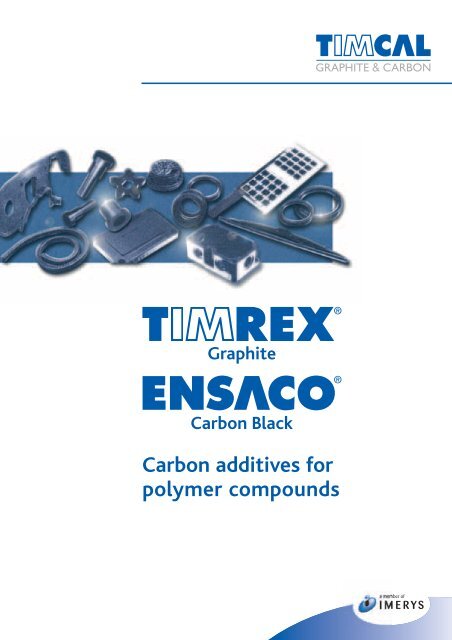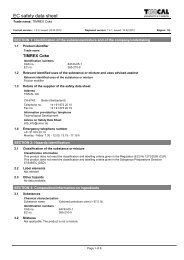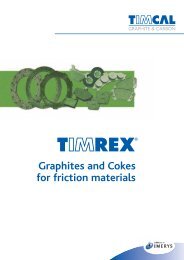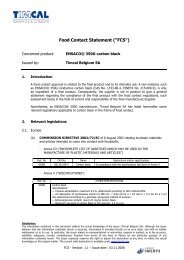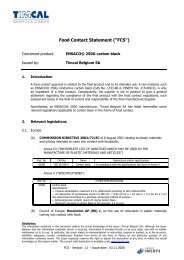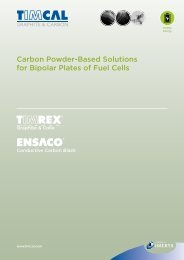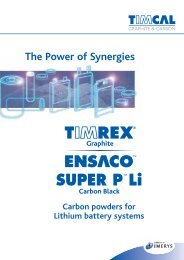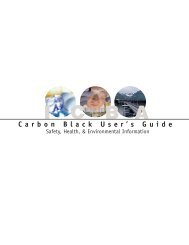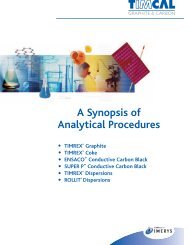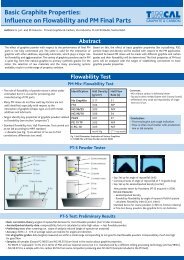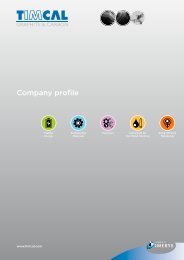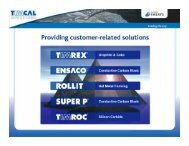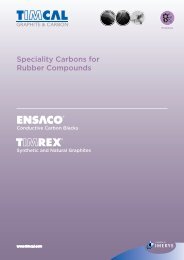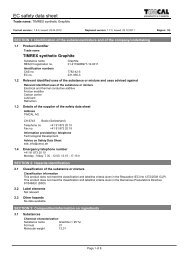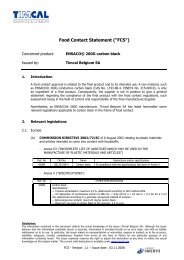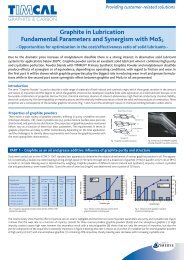ENSACO® Conductive Carbon Black for polymer ... - Timcal Graphite
ENSACO® Conductive Carbon Black for polymer ... - Timcal Graphite
ENSACO® Conductive Carbon Black for polymer ... - Timcal Graphite
You also want an ePaper? Increase the reach of your titles
YUMPU automatically turns print PDFs into web optimized ePapers that Google loves.
<strong>Graphite</strong><br />
<strong>Carbon</strong> <strong>Black</strong><br />
<strong>Carbon</strong> additives <strong>for</strong><br />
<strong>polymer</strong> compounds
Who are we?<br />
TIMCAL <strong>Graphite</strong> & <strong>Carbon</strong> has a<br />
strong tradition and history in carbon<br />
manufacturing. Its fi rst manufacturing operation<br />
was founded in 1908.<br />
Today, TIMCAL facilities produce and<br />
market a large variety of synthetic and natural<br />
graphite powders, conductive carbon<br />
blacks and dispersions of consistent high<br />
quality.<br />
Adhering to a philosophy of Total Quality<br />
Management and continuous process<br />
improvement, the TIMCAL manufacturing<br />
plants comply with ISO 9001-2000.<br />
TIMCAL <strong>Graphite</strong> & <strong>Carbon</strong> is committed<br />
to produce highly specialized graphite<br />
and carbon materials <strong>for</strong> today and tomorrow<br />
customers’ needs.<br />
TIMCAL <strong>Graphite</strong> & <strong>Carbon</strong> is a member<br />
of IMERYS, a world leader in adding<br />
value to minerals.<br />
Where<br />
are we located?<br />
With headquarters in Switzerland,<br />
TIMCAL <strong>Graphite</strong> & <strong>Carbon</strong> has an<br />
international presence with facilities and<br />
commercial offi ces located in key markets<br />
around the globe.<br />
The Group’s industrial and commercial<br />
activities are managed by an experienced<br />
multi-national team of more than 450<br />
employees, from many countries on three<br />
continents.<br />
www.timcal.com<br />
Bodio, Switzerland<br />
Willebroek, Belgium<br />
Lac-des-Îles, Canada<br />
Terrebonne, Canada<br />
Changzhou, China<br />
Baoutou, China<br />
Fuji, Japan<br />
About <strong>polymer</strong><br />
compounds<br />
Far more is expected from <strong>polymer</strong>s and<br />
their compounds than ever be<strong>for</strong>e. Designers<br />
seek to enhance physical and chemical properties<br />
and, at the same time, to slash production<br />
costs. <strong>Carbon</strong> additives are a key factor in<br />
this development.<br />
Today producers demand starting materials<br />
of outstanding definition and consistency of<br />
properties. Products whose quality is constant<br />
over decades, thus eliminating unpredictable<br />
and undesired side effects.<br />
TIMCAL <strong>Graphite</strong> & <strong>Carbon</strong> produces a<br />
variety of synthetic and natural graphite,<br />
conductive carbon black and calcined petroleum<br />
coke with a common keyword: consistency.<br />
They are manufactured under stringent<br />
process control conditions from the<br />
raw material stage through the end product.<br />
This documentation is intended to help our<br />
customers to make the best possible selection<br />
from the wide range of TIMCAL’s carbon<br />
additives available <strong>for</strong> the use in their <strong>polymer</strong><br />
compounds.<br />
TIMCAL <strong>Graphite</strong> & <strong>Carbon</strong> puts its<br />
technical experience at the customer's disposal<br />
through its Technological Development<br />
Department.<br />
Our team of experts has extensive knowledge<br />
of application processes as well as an<br />
excellent problem-solving record.<br />
Besides providing customer support, our<br />
Technological Development Department<br />
works with our Marketing Group to find new<br />
applications to meet the growing challenges<br />
facing the industry.<br />
For further in<strong>for</strong>mation please feel free to<br />
contact our team of experts who are ready to<br />
help you or visit our website: www.timcal.com
TIMREX ® <strong>Graphite</strong> and<br />
ENSACO ® <strong>Carbon</strong> <strong>Black</strong><br />
<strong>Carbon</strong> additives <strong>for</strong> <strong>polymer</strong> compounds Contents<br />
The products<br />
• Introduction to ENSACO ® <strong>Conductive</strong> <strong>Carbon</strong> <strong>Black</strong><br />
• Introduction to TIMREX ® <strong>Graphite</strong> and Coke<br />
• ENSACO ® <strong>Conductive</strong> <strong>Carbon</strong> <strong>Black</strong> <strong>for</strong> <strong>polymer</strong> compounds<br />
• TIMREX ® <strong>Graphite</strong> and Coke <strong>for</strong> <strong>polymer</strong> compounds<br />
Typical applications <strong>for</strong> ENSACO ® <strong>Conductive</strong> <strong>Carbon</strong> <strong>Black</strong><br />
• Electrically conductive plastics<br />
• Rubber<br />
• Power cables and accessories<br />
Typical applications <strong>for</strong> TIMREX ® <strong>Graphite</strong> and Coke<br />
• Self lubricating <strong>polymer</strong>s<br />
• Filled PTFE<br />
• Thermally conductive <strong>polymer</strong>s<br />
• Flame retardant <strong>polymer</strong>s<br />
pag. 4<br />
pag. 5<br />
pag. 6<br />
pag. 8<br />
pag. 10<br />
pag. 14<br />
pag. 17<br />
pag. 18<br />
pag. 20<br />
pag. 22<br />
pag. 23<br />
3
4<br />
www.timcal.com<br />
Introduction to ENSACO ®<br />
<strong>Conductive</strong> <strong>Carbon</strong> <strong>Black</strong><br />
<strong>Conductive</strong> carbon blacks are carbon blacks with high to very high void volume allowing<br />
the retention of a carbon network at low to very low filler content. The void volume<br />
can originate from the interstices between the carbon black particles, due to their<br />
complex arrangement, and from the porosity.<br />
100 nm<br />
TEM picture of <strong>ENSACO®</strong> <strong>Carbon</strong> <strong>Black</strong><br />
showing the high level of aggregation.<br />
By courtesy of University of Louvain (Louvain-La-Neuve)<br />
1 µm<br />
SEM picture of <strong>ENSACO®</strong> 250 G <strong>Carbon</strong> <strong>Black</strong><br />
illustrating the high void volume.<br />
By courtesy of University of Louvain (Louvain-La-Neuve)<br />
STM picture of the surface of <strong>ENSACO®</strong> 250 G<br />
<strong>Carbon</strong> <strong>Black</strong> 5x5 nm.<br />
By courtesy Prof. Donnet - Mulhouse<br />
100 nm<br />
SEM picture of <strong>ENSACO®</strong> 250 G <strong>Carbon</strong> <strong>Black</strong><br />
illustrating the high void volume.<br />
By courtesy of University of Louvain (Louvain-La-Neuve)<br />
How ENSACO ®<br />
<strong>Conductive</strong> <strong>Carbon</strong><br />
<strong>Black</strong>s are produced<br />
NThe <strong>Timcal</strong> carbon black process has been<br />
developed around 1980 and is commercially<br />
exploited since 1982. The plant uses most<br />
modern technology. The process is based on<br />
partial oil oxidation of carbochemical and<br />
petrochemical origin. The major difference<br />
with other partial combustion carbon black<br />
technologies lies in the aerodynamic and<br />
thermodynamic conditions:<br />
low velocity;<br />
no quench;<br />
no additives.<br />
NThis leads to a material with no or nearly<br />
no sieve residue on the 325 mesh sieve and<br />
allows the highest possible purity.<br />
NThe granulation process has been developed<br />
to achieve an homogeneously consistent<br />
product maintaining an outstanding dispersibility.<br />
It is in fact a free-flowing flake characterised<br />
by a homogeneous and very low<br />
crushing strength that guarantees the absence<br />
of bigger and harder agglomerates.<br />
The process enables the production of low<br />
surface area conductive carbon blacks as well<br />
as very high surface area conductive carbon<br />
blacks. The low surface area materials show<br />
a chain-like structure comparable to acetylene<br />
black. The very high surface area materials<br />
belong to the Extra <strong>Conductive</strong> (EC)<br />
family. Although ENSACO ® <strong>Carbon</strong> <strong>Black</strong>s<br />
are slightly more graphitic than furnace<br />
blacks, they are quite close to the latter ones<br />
as far as rein<strong>for</strong>cement is concerned.<br />
ENSACO ® <strong>Carbon</strong> <strong>Black</strong>s combine to a<br />
certain extent both the properties of furnace<br />
and acetylene black, reaching the optimal<br />
compromise.
Introduction to TIMREX ®<br />
<strong>Graphite</strong> and Coke<br />
N<strong>Graphite</strong> finds wide application because<br />
of its favourable combination of properties.<br />
These include:<br />
low friction, chemical inertness<br />
and absence of inherent abrasiveness;<br />
high thermal conductivity, thermal<br />
stability and electrical conductivity;<br />
film <strong>for</strong>ming ability on metal surfaces;<br />
relatively inoffensive nature of both<br />
Npowders and products of combustion.<br />
NThese properties are a consequence of<br />
the lamellar graphite structure and the<br />
anisotropic nature of chemical bonding<br />
between carbon atoms. In graphite, three<br />
sp 2 hybrid orbitals (each containing one<br />
electron) are <strong>for</strong>med from the 2s and two<br />
of the 2p orbitals of each carbon atom<br />
and participate in covalent bonding with<br />
three surrounding carbon atoms in the<br />
graphite planes. The fourth electron is<br />
located in the remaining 2p orbital,<br />
which projects above and below the<br />
graphite plane, to <strong>for</strong>m part of a polyaromatic<br />
π-system.<br />
SEM picture of TIMREX® <strong>Graphite</strong> showing<br />
the perfect crystalline structure.<br />
NDelocalisation of electrons in π-electron<br />
system is the cause of graphite's high stability<br />
and electrical conductivity.<br />
Interlamellar bonding was once thought<br />
to be weak and mainly the result of Van der<br />
Waals <strong>for</strong>ces, however, it now appears that<br />
interlamellar bonding is rein<strong>for</strong>ced by πelectron<br />
interactions. <strong>Graphite</strong> is there<strong>for</strong>e<br />
not intrinsically a solid lubricant and<br />
requires the presence of adsorbed vapours<br />
to maintain low friction and wear.<br />
How TIMREX ®<br />
<strong>Graphite</strong> and Coke<br />
powders are produced<br />
TIMREX ®<br />
Primary Synthetic <strong>Graphite</strong><br />
TIMREX ® Primary Synthetic <strong>Graphite</strong><br />
is produced in a unique highly controlled<br />
graphitization process which<br />
assures narrow specifications and<br />
unequalled consistent quality due to:<br />
monitoring of all production and processing<br />
stages, strict final inspection, and<br />
clearly defined development processes.<br />
TIMREX ® Primary Synthetic <strong>Graphite</strong><br />
shows unique properties thanks to the<br />
combination of a consistent purity, perfect<br />
crystalline structure and well defined<br />
texture.<br />
TIMREX ®<br />
Natural Flake <strong>Graphite</strong><br />
TIMREX ® Natural Flake <strong>Graphite</strong> is<br />
produced in a wide range of products distinguished<br />
by particle size distribution,<br />
chemistry and carbon content. <strong>Timcal</strong><br />
mines the graphite from its own source in<br />
Lac-des-Îles, Quebec, Canada. Further<br />
processing can be done either in Lac-des-<br />
Îles or <strong>for</strong> high added value products (e.g.<br />
TIMREX ® PG25) in our new processing<br />
plant in Terrebonne, Quebec, Canada. All<br />
TIMREX ® “Naturals” are thoroughly controlled<br />
in our laboratories to ensure quality,<br />
consistency and total customer satisfaction.<br />
TIMREX ® Coke<br />
TIMREX ® Petroleum Coke is calcined<br />
at appropriate temperature with low ash<br />
and sulphur content, well defined texture<br />
and consistent particle size distribution.<br />
5
6<br />
Typical values<br />
www.timcal.com<br />
ENSACO ® <strong>Conductive</strong> <strong>Carbon</strong> <strong>Black</strong><br />
<strong>for</strong> <strong>polymer</strong> compounds<br />
Property Test Method Unit ENSACO 150 G ENSACO 210 G ENSACO 250 G ENSACO 260 G ENSACO 350 G<br />
Form Granules (*) Granules Granules (*) Granules Granules<br />
BET Nitrogen Surface Area<br />
ASTM D3037<br />
OAN<br />
Absorption<br />
ASTM D2414 (1)<br />
COAN Crushed OAN<br />
ASTM D2414 (1)<br />
Pour Density<br />
ASTM D1513<br />
Moisture (as packed)<br />
ASTM D1509<br />
Sieve residue<br />
325 mesh (45 µm)<br />
ASTM D1514<br />
Ash Content<br />
ASTM D1506<br />
Volatile Content<br />
TIMCAL Method 02 (2)<br />
Sulphur Content<br />
ASTM D1619<br />
Toluene Extract<br />
ASTM D4527<br />
pH<br />
ASTM D1512<br />
Volume Resistivity<br />
TIMCAL Method 11 (3) (4)<br />
m2/g<br />
ml/100 g<br />
ml/100 g<br />
kg/m3<br />
%<br />
ppm<br />
%<br />
%<br />
%<br />
%<br />
Ohm.cm<br />
50<br />
165<br />
95<br />
190<br />
0.1<br />
2<br />
0.1<br />
0.2 max<br />
0.5 max<br />
0.1 max<br />
8-11<br />
2000 max (3)<br />
55<br />
155<br />
95<br />
210<br />
0.1<br />
2<br />
0.1<br />
0.2 max<br />
0.5 max<br />
0.1 max<br />
8-11<br />
500 max (3)<br />
65<br />
190<br />
104<br />
170<br />
0.1<br />
2<br />
0.01<br />
0.2 max<br />
0.02<br />
0.1 max<br />
8-11<br />
10 max (3)<br />
70<br />
190<br />
104<br />
170<br />
0.1<br />
2<br />
0.01<br />
0.2 max<br />
0.02<br />
0.1 max<br />
8-11<br />
5 max (3)<br />
(1) Spring: 0.9 lbs/inch; 10 g of carbon black - (2) Weight loss during heating between 105 and 950°C - (3) 25% carbon black in HDPE Finathene 47100<br />
(4) 15% carbon black in HDPE Finathene 47100<br />
(*)<strong>ENSACO®</strong> 150 and <strong>ENSACO®</strong> 250 are also available in powder <strong>for</strong>m.<br />
770<br />
320<br />
270<br />
135<br />
1 max<br />
10<br />
0.03<br />
0.3 max<br />
0.02<br />
0.1 max<br />
8-11<br />
20 max (4)
Typical effects on <strong>polymer</strong> compounds<br />
ENSACO ® <strong>Conductive</strong> <strong>Carbon</strong> <strong>Black</strong><br />
<strong>for</strong> <strong>polymer</strong> compounds<br />
Property ENSACO 150 G ENSACO 210 G ENSACO 250 G ENSACO 260 G ENSACO 350 G<br />
Form Granules (*) Granules Granules (*) Granules Granules<br />
BET Nitrogen Surface Area (m 2 /g)<br />
OAN Oil Absorption (ml/100 g)<br />
Conductivity<br />
Dispersibility<br />
Purity<br />
Water absorption<br />
Surface smoothness<br />
Electrical/Mechanical<br />
properties balance<br />
Resistance to shear<br />
Comments to<br />
application domains<br />
50<br />
165<br />
MRG<br />
(Mechanical Rubber Goods)<br />
55<br />
155<br />
Easy strippable<br />
insulation shields<br />
excellent very good good quite good difficult<br />
(*)<strong>ENSACO®</strong> 150 and <strong>ENSACO®</strong> 250 are also available in powder <strong>for</strong>m.<br />
65<br />
190<br />
very low very low very low very low high<br />
70<br />
190<br />
All <strong>polymer</strong>s<br />
770<br />
320<br />
7
8<br />
Typical values<br />
www.timcal.com<br />
TIMREX ® <strong>Graphite</strong> and Coke<br />
<strong>for</strong> <strong>polymer</strong> compounds<br />
Synthetic <strong>Graphite</strong><br />
T <strong>Graphite</strong><br />
KS <strong>Graphite</strong><br />
SFG <strong>Graphite</strong><br />
Natural <strong>Graphite</strong><br />
Particle size range<br />
d90 (µm)<br />
0 25 50 75 150<br />
0 25 50 75 150<br />
0 25 50 75 150<br />
0 25 50 75 150<br />
0 50 100 150<br />
0 50 100 150<br />
0 50 100 150<br />
T 15<br />
T 75<br />
KS 6<br />
KS 15<br />
KS 5-25<br />
KS 44<br />
KS 5-44<br />
KS 150<br />
SFG 6<br />
SFG 44<br />
SFG 150<br />
Ash<br />
(%)<br />
0.08<br />
0.07<br />
0.06<br />
0.05<br />
0.03<br />
0.06<br />
0.02<br />
0.06<br />
0.07<br />
0.07<br />
0.03<br />
PG <strong>Graphite</strong> 200<br />
Solid content<br />
(%)<br />
0.10 1.17 6.5 27.5
Typical effects on <strong>polymer</strong> compounds<br />
TIMREX ® <strong>Graphite</strong> and Coke<br />
<strong>for</strong> <strong>polymer</strong> compounds<br />
Synthetic <strong>Graphite</strong><br />
T <strong>Graphite</strong><br />
Extra Fine<br />
Fine<br />
KS <strong>Graphite</strong> Extra Fine<br />
Fine<br />
Fine-Special<br />
Coarse<br />
SFG <strong>Graphite</strong> Extra Fine<br />
Fine<br />
Coarse<br />
Natural <strong>Graphite</strong><br />
PG <strong>Graphite</strong> Extra Fine<br />
Fine<br />
FR <strong>Graphite</strong> Coarse<br />
Special <strong>Graphite</strong><br />
B <strong>Graphite</strong> BNB90<br />
PC Coke<br />
Flare <strong>Graphite</strong><br />
LB Dispersion<br />
PC40<br />
Coarse<br />
LB1300<br />
Thermally conductive<br />
<strong>polymer</strong><br />
Thermal<br />
conductivity<br />
4 W/(m.K)<br />
Self<br />
Lubrication<br />
Self lubricating<br />
<strong>polymer</strong>s<br />
Friction<br />
Modification<br />
Wear<br />
Reduction<br />
excellent good quite good neutral negative<br />
*<br />
Creep<br />
resistence<br />
Filled<br />
PTFE<br />
De<strong>for</strong>mation<br />
under loading<br />
Flame<br />
retardant<br />
Intumescent<br />
effect<br />
Processability<br />
low carbon<br />
loading<br />
high carbon<br />
loading<br />
* in PTFE<br />
9
10<br />
The selection of a<br />
conductive carbon black<br />
NENSACO ® <strong>Conductive</strong> <strong>Carbon</strong> <strong>Black</strong>s find<br />
their applications in an unlimited number of<br />
plastics. The combination of the <strong>polymer</strong> type<br />
and grade and the carbon black grade are determining<br />
the overall electrical and mechanical<br />
per<strong>for</strong>mance.<br />
NThe main parameter influencing the final<br />
conductivity of a finished part in a given <strong>polymer</strong><br />
is the type and level of carbon black used.<br />
NThe higher the structure of the carbon black,<br />
the lower the level of carbon black needed to<br />
achieve the required conductivity. Nevertheless,<br />
in a minor way, other parameters like the additives<br />
in presence, the compounding or processing<br />
conditions may also influence the final conductivity<br />
of parts.<br />
NLow surface area conductive carbon blacks<br />
show a particular advantage on dispersion and<br />
processing.<br />
NPercolation curves – correlating the volume<br />
resistivity and the carbon black percentage – are<br />
a useful comparative tool to predict the conductivity<br />
in place and to select the more appropriate<br />
system. These curves are valid <strong>for</strong> a given <strong>for</strong>mulation<br />
and sample preparation technique.<br />
NThe selection of the conductive carbon black<br />
will also influence:<br />
the compounding behaviour<br />
(dispersibility, resistance to shear, mixing cycle,<br />
melt flow index, extrusion throughput);<br />
the surface appearance of the finished<br />
material (number of surface defects);<br />
the mechanical properties<br />
(<strong>polymer</strong> property retention, rein<strong>for</strong>cement);<br />
the overall price – per<strong>for</strong>mance ratio.<br />
www.timcal.com<br />
Typical applications <strong>for</strong> ENSACO ® <strong>Conductive</strong> <strong>Carbon</strong> <strong>Black</strong><br />
Electrically<br />
conductive plastics<br />
The preparation of a<br />
conductive compound<br />
NSuitable mixing equipments <strong>for</strong> the preparation<br />
of black conductive compounds include<br />
internal mixers, twin screw extruders, single<br />
screw kneader machines and LCM. The feeding<br />
of low bulk density, soft flake-type carbon<br />
blacks into extruders requires the use of twin<br />
screw feeders and separate introduction on an<br />
already molten <strong>polymer</strong> (split feeding technology).<br />
Some typical final plastics<br />
applications:<br />
handling of electronic components:<br />
carrier boxes, carrier trays, carrier tapes, etc.;<br />
films: antistatic and conductive films,<br />
packaging films, garbage bags, etc.;<br />
automotive industry: fuel injection systems,<br />
anticorrosion systems, fuel tank inlet,<br />
electrostatically paintable parts, etc.;<br />
transport: mobile phone parts, wheels,<br />
containers, bins, pallets, etc.;<br />
computer: antistatic articles <strong>for</strong> computer<br />
& accessories, CD player, etc.;<br />
health: medical applications,<br />
cleanroom equipments, articles <strong>for</strong><br />
antistatic workplaces, etc.;<br />
antistatic flooring;<br />
heating element;<br />
sensors;<br />
PTC switches;<br />
UV protection and pigmentation.<br />
In the following pages there are some of the<br />
results of experimental work carried out on<br />
ENSACO ® <strong>Conductive</strong> <strong>Carbon</strong> <strong>Black</strong>s in different<br />
<strong>polymer</strong> compounds.<br />
The data shown here are given as orientation<br />
and are valid <strong>for</strong> the particular <strong>for</strong>mulations<br />
and sample preparation technique<br />
mentioned. Results in other <strong>polymer</strong>s, full<br />
studies and publications are available upon<br />
request.
ENSACO ® <strong>Conductive</strong> <strong>Carbon</strong> <strong>Black</strong>s in HDPE<br />
Volume Resistivity (Ohm.cm)<br />
Volume Resistivity (Ohm.cm)<br />
Volume Resistivity (Ohm.cm)<br />
10 9<br />
10 7<br />
10 5<br />
10 3<br />
10<br />
0.1<br />
0<br />
800<br />
700<br />
600<br />
500<br />
400<br />
300<br />
200<br />
100<br />
0<br />
4<br />
7.0<br />
6.5<br />
6.0<br />
5.5<br />
5.0<br />
4.5<br />
4.0<br />
3.5<br />
3.0<br />
4<br />
Various carbon blacks in HDPE<br />
E 250<br />
E 260<br />
E 350<br />
10 20 30 40 50<br />
% <strong>Carbon</strong> <strong>Black</strong> Concentration (%)<br />
Resistivity vs mixing time - 18% carbon black<br />
E 250<br />
E 260<br />
5 6 7 8 9 10<br />
Brabender Mixing Time (min)<br />
Resistivity vs mixing time - 25% carbon black<br />
E 250<br />
E 260<br />
5 6 7 8 9 10<br />
Brabender Mixing Time (min)<br />
Influence of the carbon black type<br />
on the resistivity:<br />
Compounding: laboratory Brabender<br />
internal mixer.<br />
Processing: compression moulding.<br />
The higher the structure of the carbon black, the lower<br />
the percolation threshold.<br />
At a concentration very near to the percolation level,<br />
when overmixed, ENSACO ® 260 G offers a higher<br />
consistency in resistivity resulting from its higher<br />
shear stability in extreme working conditions.<br />
At a concentration far above the percolation level,<br />
both blacks are very stable in resistivity when overmixed.<br />
ENSACO ® 260 G shows a consistent lower<br />
resistivity.<br />
11
12<br />
www.timcal.com<br />
ENSACO ® <strong>Conductive</strong> <strong>Carbon</strong> <strong>Black</strong>s in LDPE<br />
Volume Resistivity (Ohm.cm)<br />
Volume Resistivity (Ohm.cm)<br />
10 8<br />
10 6<br />
10 4<br />
10 2<br />
10 0<br />
10 4<br />
10 3<br />
10 2<br />
10 1<br />
10 0<br />
Various carbon black in LDPE MFI 0.3 and 36 (g/10 min)<br />
E250 G LD 0.3<br />
E250 G LD 36<br />
N472 LD 0.3<br />
N472 LD 36<br />
P-type LD 0.3<br />
P-type LD 36<br />
0 5 10 15 20 25 30 35<br />
<strong>Carbon</strong> <strong>Black</strong> Concentration (%)<br />
ENSACO ® <strong>Conductive</strong> <strong>Carbon</strong> <strong>Black</strong>s in PP<br />
PPH MI54 (230 °C/5 kg) with various conductive carbon blacks<br />
E250 G: high structure - low surface area<br />
N472: high structure - high surface area<br />
1 10<br />
MFI (230 °C/5 kg) (g/10 min)<br />
100<br />
Influence of the carbon black type on the resistivity.<br />
Relation between resistivity and melt flow index:<br />
Compounding and processing: twin screw extruder Haake PTW16 and realization<br />
of tapes.<br />
At same structure level, the carbon black with the lowest surface area has the<br />
smallest impact on fluidity reduction.<br />
Volume Resistivity (Ohm.cm)<br />
10 5<br />
10 4<br />
10 3<br />
10 2<br />
10 1<br />
10 0<br />
Influence of the carbon black type and of the MFI of<br />
the starting <strong>polymer</strong> on the resistivity:<br />
Compounding: laboratory Brabender internal mixer.<br />
Processing: compression moulding.<br />
The higher the structure of the carbon black, the lower the percolation<br />
threshold.<br />
At equal structure, the carbon black of lower surface area gets an advantage<br />
on resistivity that may be coming from the easier dispersion resulting<br />
in smoother compounding.<br />
The higher the meltflow index of the starting <strong>polymer</strong>, the lower the<br />
percolation threshold.<br />
171<br />
24<br />
13.50% E250 G<br />
15% E250 G<br />
10<br />
strands pellets + pressed<br />
plaques<br />
6<br />
4.6E+10<br />
54<br />
pellets +<br />
injection moulding<br />
Influence of carbon black loading and processing<br />
on the resistivity:<br />
Compounding: ZSK25 twin screw extruder.<br />
Processing: injection moulding.<br />
Injection moulding generates more shear than compression moulding.<br />
The closest to the percolation, the more visible is that effect. A concentration<br />
safety margin can overcome this phenomenon.
ENSACO ® <strong>Conductive</strong> <strong>Carbon</strong> <strong>Black</strong>s in PC<br />
Volume Resistivity (log Ohm.cm)<br />
Izod (KJ/m 2 )<br />
Tensile Strength (MPa)<br />
12<br />
11<br />
10<br />
9<br />
8<br />
7<br />
6<br />
5<br />
4<br />
3<br />
2<br />
Volume Resistivity (VR) in function of carbon black loading<br />
1<br />
5 10 15 20 25<br />
12<br />
11<br />
10<br />
9<br />
8<br />
7<br />
6<br />
5<br />
<strong>Carbon</strong> <strong>Black</strong> concentration (%)<br />
Izod impact strength, notched, in function of VR<br />
E250 G<br />
E350 G<br />
E250 G<br />
E350 G<br />
4<br />
1 2 3 4 5 6 7 8 9 10 11 12<br />
Volume Resistivity (log Ohm.cm)<br />
68<br />
67<br />
66<br />
65<br />
64<br />
63<br />
62<br />
61<br />
Tensile strength in function of VR<br />
E250 G<br />
E350 G<br />
60<br />
1 2 3 4 5 6 7 8 9 10 11 12<br />
Volume Resistivity (log Ohm.cm)<br />
Influence of the carbon black type<br />
on the resistivity:<br />
Compounding: ZSK57 twin screw extruder.<br />
Processing: injection moulding.<br />
Influence of the carbon black type on mechanical and<br />
rheological per<strong>for</strong>mances:<br />
Compounding: ZSK57 twin screw extruder.<br />
Processing: injection moulding.<br />
Although the concentration <strong>for</strong> percolation is double the level with<br />
ENSACO ® 250 G, most mechanical properties are still better.<br />
Tensile Strength <strong>for</strong> both carbon blacks is almost at the same level.<br />
13
14<br />
Rubber<br />
<strong>Carbon</strong> black is one of the main ingredients<br />
of any rubber compound. <strong>Conductive</strong> carbon<br />
blacks are be<strong>for</strong>e all carbon blacks, to be mixed<br />
and handled as any other rein<strong>for</strong>cing or semirein<strong>for</strong>cing<br />
carbon black. They are high structure<br />
materials bulky by nature. Although the<br />
common carbon blacks are conductive by<br />
nature and impart also conductivity to the<br />
compounds when used in sufficiently high<br />
loading, conductive carbon blacks have the<br />
advantage to reach conductivities at lower loading<br />
and are often used to give the final boost to<br />
a compound already filled with other carbon<br />
blacks. As carbon black structure is the parameter<br />
determining the conductivity, structure<br />
being an additive property, the combinations of<br />
conductive and normal black can be predicted.<br />
Specifications of rubber compounds being<br />
usually quite complex and conductivity being<br />
only one of the numerous physical requirements,<br />
the use of carbon black blends is very<br />
often the only solution.<br />
In some specific cases, especially in special<br />
<strong>polymer</strong>s, it occurs that the conductive carbon<br />
black is used by its own in order to maintain<br />
mechanical properties and processing at a good<br />
level.<br />
ENSACO ® carbon blacks are, as mentioned<br />
above, quite close to furnace blacks as far as the<br />
rein<strong>for</strong>cing activity is concerned. Especially the<br />
low surface area carbon blacks, grades 150, 250<br />
and 260, are, due to their very easy dispersion,<br />
quite per<strong>for</strong>ming in most rubber compounds.<br />
ENSACO ® 350 is also used in some compounds<br />
where small additions are required.<br />
www.timcal.com<br />
Typical applications <strong>for</strong> ENSACO ® <strong>Conductive</strong> <strong>Carbon</strong> <strong>Black</strong><br />
A few conductive<br />
applications:<br />
belt cover compounds;<br />
flooring;<br />
conveyer belts;<br />
hoses <strong>for</strong> fuel, <strong>for</strong> conveying<br />
of powders, etc.;<br />
cylinder coating;<br />
shoe soles;<br />
seals.<br />
ENSACO ® 150 and 250 are also used in non<br />
conducting applications where the compounder<br />
can take profit of the low surface area and high<br />
structure of those blacks:<br />
low hysteresis with relatively high hardness;<br />
good thermal aging;<br />
very good tear strength;<br />
very good dispersion, very good mechanical<br />
per<strong>for</strong>mance at thin layer.<br />
A few non-conductive<br />
applications:<br />
antivibration systems;<br />
textile coating;<br />
membranes;<br />
articles exposed to chipping and chunking.<br />
In the following pages there are some of the<br />
results of experimental work carried out on<br />
ENSACO ® <strong>Conductive</strong> <strong>Carbon</strong> <strong>Black</strong>s in different<br />
rubber compounds.<br />
The data shown here are given as orientation<br />
and are valid <strong>for</strong> the particular <strong>for</strong>mulations<br />
and sample preparation technique<br />
mentioned. Results in other <strong>polymer</strong>s, full<br />
studies and publications are available upon<br />
request.
NBR conductive hose compound<br />
NBR NT 3945<br />
Ensaco 250<br />
N-472<br />
N-550<br />
ZnO<br />
Stearic acid<br />
DOP<br />
Sulphur<br />
Methyl Thuads<br />
Amax<br />
By courtesy of Bayer<br />
<strong>Conductive</strong> CR conveyor belt cover compound<br />
Bayprene 610 (CR)<br />
Buna CB 10<br />
MgO Powder<br />
N-472<br />
Ensaco 250<br />
Vulkanox DDA<br />
Vulkanox 4020<br />
Ingralen 450<br />
ZnO Powder<br />
Rhenogran ETU-80<br />
Stearic acid<br />
By courtesy of Bayer<br />
A B<br />
Compound<br />
ENSACO 250<br />
A B<br />
Compound<br />
ENSACO 250<br />
100<br />
25<br />
40<br />
4<br />
0.5<br />
30<br />
0.4<br />
2<br />
2<br />
100<br />
2<br />
4<br />
30<br />
1.5<br />
0.5<br />
15<br />
5<br />
0.2<br />
0.5<br />
Compound<br />
N-472<br />
100<br />
25<br />
40<br />
4<br />
0.5<br />
30<br />
0.4<br />
2<br />
2<br />
Compound<br />
N-472<br />
100<br />
2<br />
4<br />
30<br />
1.5<br />
0.5<br />
15<br />
5<br />
0.2<br />
0.5<br />
t90% (min)<br />
Mooney ML (1+4) at 100° C<br />
Vulcanizate data unaged at RT<br />
Shore A Hardness<br />
Stress-strain<br />
Elongation at break (%)<br />
Tensile Strength (Mpa)<br />
Modulus 100% (Mpa)<br />
Modulus 300% (Mpa)<br />
Modulus 500% (Mpa)<br />
Resistivity (Ohm.cm)<br />
Tear Strength (N/mm)<br />
Dispersion Rating DIK<br />
t90% (min)<br />
Mooney ML(1+4) at 100°C<br />
Vulcanizate data unaged at RT<br />
Shore A hardness<br />
Stress-strain<br />
Elongation at break (%)<br />
Tensile Strength (Mpa)<br />
Modulus 50% (Mpa)<br />
Modulus 100% (Mpa)<br />
Modulus 300% (Mpa)<br />
Modulus 500% (Mpa)<br />
Compression Set 24h at 70°C (%)<br />
Resistivity (Ohm.cm)<br />
A B<br />
Compound<br />
ENSACO 250<br />
86.8<br />
20.7<br />
62<br />
A B<br />
Compound<br />
ENSACO 250<br />
11.46<br />
45.7<br />
70.9<br />
339<br />
13.8<br />
3.9<br />
8.6<br />
12.6<br />
79<br />
32.4<br />
62<br />
676<br />
23.4<br />
1.2<br />
2.4<br />
9.2<br />
16.1<br />
18<br />
100<br />
Compound<br />
N-472<br />
11.37<br />
47.2<br />
72.2<br />
311<br />
14.8<br />
4.6<br />
10.3<br />
14.4<br />
360<br />
31.8<br />
Compound<br />
N-472<br />
85.8<br />
21.8<br />
64<br />
64<br />
540<br />
22.4<br />
1.4<br />
2.7<br />
11.5<br />
20.6<br />
19<br />
800<br />
15
16<br />
FKM conductive compounds<br />
www.timcal.com<br />
1 2 3 4 5 6 7 8 9<br />
VITON A-32J - Fluoroelastomer 100 100 100 100 100 100 100 100 100<br />
MgO<br />
3 3 3 3 3 3 3 3 3<br />
Ca(OH) 2<br />
3 3 3 3 3 3 3 3 3<br />
MT black<br />
20 -<br />
- -<br />
-<br />
-<br />
- 20 20<br />
ENSACO 250G<br />
- 10 20 30 -<br />
-<br />
- 10 20<br />
N-472 SCF<br />
-<br />
-<br />
- - 10 20 30 -<br />
-<br />
VPA-2<br />
1 1 1 1 1 1 1 1 1<br />
Total phr 127.0 117.0 127.0 137.0 117.0 127.0 137.0 137.0 147.0<br />
MT black % 15.7 0.0 0.0 0.0 0.0 0.0 0.0 14.6 13.6<br />
E250G % 0.0 8.5 15.7 21.9 0.0 0.0 0.0 7.3 13.6<br />
SCF N-472 % 0.0 0.0 0.0 0.0 8.5 15.7 21.9 0.0 0.0<br />
Experimental data provided by DuPont Dow Elastomers, Japan<br />
180<br />
160<br />
140<br />
120<br />
100<br />
80<br />
60<br />
40<br />
20<br />
Mooney viscosity ML (1+10’), 100°C<br />
(*)<br />
0<br />
1 2 3 4 5 6 7 8 9<br />
(*)Rejected because uncurable.<br />
Vulcanizate properties at 177°C <strong>for</strong> 10 min.<br />
70<br />
60<br />
50<br />
40<br />
30<br />
20<br />
10<br />
0<br />
Compression set (%)<br />
1 2 3 4 5 6 8 9<br />
20<br />
18<br />
16<br />
14<br />
12<br />
10<br />
8<br />
6<br />
4<br />
2<br />
0<br />
100<br />
90<br />
80<br />
70<br />
60<br />
50<br />
40<br />
30<br />
20<br />
10<br />
0<br />
t 90% (min)<br />
1 2 3 4 5 6 8 9<br />
Shore A<br />
1 2 3 4 5 6 8 9<br />
14<br />
12<br />
10<br />
8<br />
6<br />
4<br />
2<br />
0<br />
Log Resistivity (Ohm.cm)<br />
1 2 3 4 5 6 8 9
Typical applications <strong>for</strong> <strong>ENSACO®</strong> <strong>Conductive</strong> <strong>Carbon</strong> <strong>Black</strong><br />
Power cables<br />
and accessories<br />
N<strong>Conductive</strong> carbon black is used in semicon<br />
compounds <strong>for</strong> conductor and insulator shields.<br />
NThe requirements <strong>for</strong> those compounds are<br />
besides processing, a sufficient electrical conductivity,<br />
a smooth or even supersmooth surface<br />
finish, and high purity.<br />
NFor strippable or easy strippable compounds<br />
these requirements are added to a specific adhesion<br />
strength between the insulating layer and<br />
the insulator shield. These strippable or easy<br />
strippable layers have to peeled of by hand or<br />
using a specific peeling device.<br />
NTypical <strong>polymer</strong> compositions are polyolefins<br />
or co<strong>polymer</strong>s; <strong>for</strong> strippable compounds quite<br />
often blends of EVA and NBR are used.<br />
Typical EVA/NBR strippable compounds<br />
Levaprene 450<br />
Perbunan NT 8625<br />
Rhenogran P60<br />
N-472<br />
E 210<br />
E 250<br />
N-550<br />
Antilux 654<br />
Zn Stearate<br />
Rhenovin DDA-70<br />
Rhenofit TAC/CS<br />
Percadox BC-408<br />
Viscosity ML (4+1)<br />
Rheometer@180 t90%<br />
Mechanical properties<br />
Non aged (diff. aged)<br />
Tensile strength MPa<br />
Elongation at break %<br />
Modulus 100% MPa<br />
Shore A<br />
Peel strength hot air 100°C N<br />
after 3 days N<br />
after 21 days N<br />
Volume resistivity (Ohm.cm)<br />
Compound<br />
N-472<br />
90<br />
10<br />
3<br />
40<br />
40<br />
10<br />
1<br />
1.4<br />
4.3<br />
5<br />
56<br />
3.6<br />
16.5 (-19)<br />
215 (-58)<br />
11<br />
87 (+7)<br />
7<br />
5<br />
5<br />
210<br />
Compound<br />
ENSACO 210<br />
90<br />
10<br />
3<br />
40<br />
40<br />
10<br />
1<br />
1.4<br />
4.3<br />
5<br />
44<br />
3.6<br />
16.9 (-15)<br />
180 (-50)<br />
12.2<br />
90 (+4)<br />
3<br />
4<br />
3<br />
6600<br />
Typical EEA/EBA semicon compounds<br />
EEA<br />
EBA<br />
E 250<br />
Peroxide<br />
Mixing cond. L/D15; Feed BC; Truput 30<br />
Resistivity @ RT<br />
Resistivity @ 90°C<br />
<strong>Carbon</strong> black dispersion:
18<br />
Self lubricating<br />
<strong>polymer</strong>s<br />
NThe choice of a <strong>polymer</strong>-based self lubricating<br />
solid <strong>for</strong> a particular application depends<br />
mainly upon the operating conditions of:<br />
temperature, chemical environment and the<br />
maximum values of pressure (p) and sliding<br />
speed (v). For each <strong>polymer</strong> or composite<br />
material, a pv limit is quoted, which corresponds<br />
to the pressure times the sliding speed<br />
at which the material fails, either due to unacceptable<br />
de<strong>for</strong>mation, or to the high frictional<br />
energy dissipated causes surface melting,<br />
softening and excessive wear.<br />
NThe pv limit of a <strong>polymer</strong>ic material may<br />
be increased by increasing its mechanical<br />
strength (resistance to de<strong>for</strong>mation), thermal<br />
conductivity (reduction in surface temperatures)<br />
and by decreasing friction (reduces frictional<br />
heating). In practice, thermoplastics<br />
(with the exception of PTFE) are mainly used<br />
as pure solids, since their wear resistance and<br />
frictional coefficient, are satisfactory <strong>for</strong><br />
most applications. Solid lubricant fillers or<br />
fibre rein<strong>for</strong>cement (glass fibres, carbon<br />
fibres, textiles) are only employed under the<br />
more extreme conditions of load and speed.<br />
NThe major <strong>polymer</strong>s employed as self lubricating<br />
solids/composites, are illustrated<br />
below.<br />
www.timcal.com<br />
Typical applications <strong>for</strong> TIMREX® <strong>Graphite</strong> and Coke<br />
Thermoplastics Thermosetting <strong>polymer</strong>s<br />
polyamides*<br />
polyester<br />
polyacetal*<br />
polyethylene (HDPE, UHMWPE)<br />
Polycarbonate<br />
poly (ether etherketone)*<br />
polyphenilenesulphide*<br />
polysulphone*<br />
epoxy resins*<br />
phenolic resins*<br />
unsatured polyester*<br />
polyimides*<br />
Major <strong>polymer</strong>s employed as self lubricating solids.<br />
* <strong>polymer</strong>s in which graphite<br />
may be incorporated<br />
N <strong>Graphite</strong> powder is widely used in <strong>polymer</strong><br />
composites, either alone or in combination<br />
with rein<strong>for</strong>cing fibres, PTFE or various inorganic<br />
fillers, e.g. mica, talc (bottom, right<br />
table). Applications include gears, dry sliding<br />
bearings, seals, automotive and micro-mechanical<br />
parts. The properties of graphite which<br />
favour its use in <strong>polymer</strong> composites are:<br />
low friction lamellar solid<br />
(reduces friction);<br />
tendency to <strong>for</strong>m a transfer film<br />
on the countersurface<br />
(assists in wear reduction, particularly<br />
when graphite is applied as water based<br />
dispersion i.e. LB 1300);<br />
high thermal conductivity<br />
(decreases temperature rise due to<br />
frictional heating);<br />
electrical conductivity<br />
(prevent build-up of static charge which<br />
may be a problem in some cases);<br />
chemically inert<br />
(used in conjunction with PTFE in<br />
corrosive environments);<br />
high thermal stability<br />
(favours use in high temperature<br />
applications, e.g. polyimide graphite<br />
composites may be used up to 350°C).<br />
Polymer <strong>Graphite</strong> content Other additives<br />
polyacetal<br />
polyamide 6<br />
polyamide 11<br />
polyamide 12<br />
polyamide 6.6<br />
polysulphone<br />
polyphenilenesulphide<br />
polyphenyleneoxide<br />
PTFE<br />
polymide<br />
polymide<br />
polymide<br />
phenolic / epoxy resin<br />
polyester thermoset<br />
10%<br />
5%<br />
10%<br />
30%<br />
5%<br />
15-30%<br />
10%<br />
10%<br />
15-40%<br />
15-40%<br />
15%<br />
40%<br />
5-20%<br />
5-20%<br />
Examples of the use of graphite in self lubricating <strong>polymer</strong>s.<br />
-<br />
-<br />
glass fibre<br />
PTFE<br />
-<br />
inorganic filler<br />
glass fibre<br />
inorganic filler<br />
glass fibre<br />
-<br />
PTFE<br />
CF<br />
CF/glass fibre<br />
CF/glass fibre<br />
-<br />
-<br />
25%<br />
15%<br />
-<br />
10%<br />
30%<br />
20%<br />
10-20%<br />
-<br />
20%<br />
10%
Incorporation of graphite powder into a<br />
thermoplastic <strong>polymer</strong> will generally result in<br />
a reduction in the friction coefficient (with<br />
the exception of PTFE) but rarely improves<br />
the wear resistance. This behaviour is illustrated<br />
in the two graphs, which show the<br />
mean friction coefficient and specific wear<br />
rate <strong>for</strong> a stainless steel ball (ø = 5 mm) rubbing<br />
on discs of graphite filled polystyrene<br />
and polyamide at constant load (32.5 N) and<br />
speed (0.03 m/s). The specific wear rates of<br />
the graphite-<strong>polymer</strong> composites were calculated<br />
from the diameters of the wear tracks<br />
and the contact geometry.<br />
In the case of polystyrene, addition of 30-<br />
50% of a high purity macrocrystalline synthetic<br />
graphite (T 75), reduced both friction<br />
and wear rate. With polyamide however,<br />
addition of a graphite similar to T 75 reduced<br />
the friction coefficient, but caused a slight<br />
increase in the wear rate, with the finer particle<br />
size powder (KS 6) giving the better result.<br />
In the case of low density polyethylene and<br />
polypropylene, graphite incorporation causes<br />
both an increase in friction and wear.<br />
The results described above are thought to<br />
be related to the strength of adhesion at the<br />
<strong>polymer</strong>-graphite interface, which depends<br />
upon the wettability of the powder by the<br />
molten <strong>polymer</strong>, powder surface area to volume<br />
ratio, surface chemistry, etc.<br />
In simple terms, polystyrene shows a strong<br />
affinity <strong>for</strong> the graphite surface, while polyolefins<br />
show a weak affinity.<br />
Interfacial adhesion increases with increasing<br />
powder surface area to volume ratio, or<br />
decreasing particle size.<br />
Ball/Disc Friction & Wear Data<br />
polystyrene/graphite filler<br />
specific wear (m/Nm)x10 friction coefficient<br />
12<br />
0.4<br />
10<br />
8<br />
6<br />
4<br />
2<br />
0<br />
3 -12<br />
pure polystyrene 30% T 75 50% T 75<br />
wear<br />
friction<br />
Influence of graphite addition on the specific wear rate<br />
and friction of polystyrene<br />
0.3<br />
0.2<br />
0.1<br />
For this reason relatively fine graphite powders<br />
(95%
20<br />
Filled PTFE<br />
Polytetrafluoroethylene (PTFE) exhibits a<br />
very low coefficient of friction and retains useful<br />
mechanical properties at temperatures from<br />
-260 to +260 °C <strong>for</strong> continuous use.<br />
The crystalline melting point is 327 °C, much<br />
higher than that of most other semi- crystalline<br />
<strong>polymer</strong>s. Furthermore, PTFE is nearly inert<br />
chemically and does not adsorb water, leading<br />
to excellent dimensional stability. On the one<br />
hand, these characteristics of PTFE are very<br />
useful in the matrix <strong>polymer</strong> of <strong>polymer</strong>-based<br />
composites which are used in sliding applications.<br />
On the other hand, PTFE is subjected to<br />
marked cold flow under stress (de<strong>for</strong>mation<br />
and creep) and reveals the highest wear among<br />
the semicrystalline <strong>polymer</strong>s.<br />
NHowever, these disadvantages are very<br />
much improved by incorporating suitable<br />
fillers, allowing the use of PTFE in fields otherwise<br />
precluded to this <strong>polymer</strong>.<br />
NThe treated PTFE is generally known as<br />
filled-PTFE. There are many kinds of filled-<br />
PTFE composite because various fillers are<br />
incorporated into PTFE and one or more<br />
materials can be used simultaneously. Usually,<br />
these fillers are in <strong>for</strong>m of powders or fibers<br />
intimately mixed with the PTFE.<br />
NThe addition of fillers to the PTFE<br />
improves or modifies its properties depending<br />
upon the nature and quantity of filler:<br />
remarkable increase in wear resistance;<br />
decrease of de<strong>for</strong>mation under load<br />
and of creep;<br />
reduction of thermal expansion;<br />
some types of filler increase the<br />
thermal and electric conductivity.<br />
NFilled PTFE is often not as strong and<br />
resilient as virgin PTFE. Sometimes, the filler<br />
limits the resistance to chemical agents and<br />
modify the electrical properties.<br />
www.timcal.com<br />
Typical applications <strong>for</strong> TIMREX® <strong>Graphite</strong> and Coke<br />
TIMREX ® <strong>Graphite</strong><br />
and Coke fillers in filled-PTFE<br />
TIMREX ® PC 40 Coke<br />
TIMREX PC 40 Coke is calcined at high<br />
temperatures offering low sulphur concentration,<br />
low content of oversize particles, high<br />
apparent density and high chemical stability<br />
against most chemical substances. TIMREX ®<br />
PC 40 Coke is added to the virgin PTFE in a<br />
percentage by weight between 10 and 35%<br />
along with small percentage of graphite.<br />
Compounds made of PTFE and TIMREX ®<br />
PC 40 Coke have excellent wear resistance<br />
and de<strong>for</strong>mation strength and compared to<br />
the virgin PTFE, they have practically<br />
unchanged chemical resistance and friction<br />
behaviour.<br />
Typical final materials that can be produced<br />
with coke filled PTFE are:<br />
engineering design components, slide bearings,<br />
valve housing and valve seats <strong>for</strong> chemical<br />
applications, piston sealing and guiding<br />
elements <strong>for</strong> dry-running compressors.<br />
TIMREX ®<br />
KS44 Synthetic <strong>Graphite</strong><br />
NTIMREX ® KS 44 is a Primary Synthetic<br />
<strong>Graphite</strong> obtained by the full graphitisation of<br />
amorphous carbon materials through the well<br />
known Acheson process. The process parameters<br />
in the Acheson furnace such as temperatures<br />
and residential times are all optimised in<br />
order to achieve the perfect degree of crystallinity<br />
and the lowest level of impurities<br />
whereas others minor adjustments are made<br />
during the material sizing and conditioning.<br />
NThe percentage of TIMREX ® KS 44 used in<br />
the filled PTFE vary between 5 and 15%.<br />
NTIMREX ® KS 44 can be used alone or in<br />
combination with glass or coke.<br />
TIMREX ® KS 44 lowers the coefficient of<br />
friction and is, there<strong>for</strong>e, often added to other<br />
types of filled PTFE <strong>for</strong> improving this property<br />
(and also to improve the lifetime of the<br />
cutting tools during <strong>for</strong> instance the production<br />
of gaskets and seals).<br />
It improves the de<strong>for</strong>mation under load,<br />
strength and, to a minor degree the wear. Like<br />
coke, it serves well in corrosive environments.<br />
PTFE filled with TIMREX ® KS 44 are often<br />
used in steering and shock-absorber gasket,<br />
bearings as well as in slide films <strong>for</strong> anti-static<br />
applications.
Influence of TIMREX ® <strong>Graphite</strong><br />
and Coke fillers in filled-PTFE<br />
Wear resistance:<br />
virgin PTFE shows much high wear as a result<br />
of the destruction of the banded structure due<br />
to easy slippage between the crystalline lamellae<br />
in the bands.<br />
The presence of well distributed carbon particles<br />
in the filled PTFE partially avoid the slippage<br />
between the crystalline lamellae in the<br />
bands and there<strong>for</strong>e the wear resistance is<br />
improved.<br />
De<strong>for</strong>mation strength:<br />
virgin PTFE de<strong>for</strong>mation behaviour is somehow<br />
similar to the mechanism previously<br />
described. In someway the de<strong>for</strong>mation phenomena<br />
could be explained by the tendency<br />
of slippage that occurs between the crystalline<br />
lamellae. However, in this case the presence of<br />
well distributed carbon particles in the filled<br />
PTFE offers only a partial explanation to the<br />
phenomena because also hardness of these<br />
particles is important in determine an<br />
improvement of the de<strong>for</strong>mation behaviour.<br />
Friction Coefficient:<br />
the coefficient of friction <strong>for</strong> various filled<br />
PTFE composites is weakly dependent upon<br />
the incorporated filler, because a thin PTFE<br />
film generally exists at the interface between<br />
the body and counter-body. Consequently the<br />
coefficient of friction is both similar in the<br />
filled PTFE and virgin PTFE. This evidence is<br />
true as long as no oversize particles are present<br />
in the filler. In fact the presence of oversize<br />
particles could lead to a radically modification<br />
of the coefficient of friction. Because of that in<br />
carbons as well as in other fillers is very important<br />
the control of oversize particles.<br />
21
22<br />
Thermally<br />
conductive <strong>polymer</strong>s<br />
NThe ability of a material to conduct heat is<br />
known as its thermal conductivity. Thermal<br />
conductivity itself is nothing else than transportation<br />
of thermal energy from high to low<br />
temperature regions. Thermal energy within<br />
a crystalline solid is conducted by electrons<br />
and/or discrete vibrational energy packets<br />
(phonons*). Each effect, phonons and movement<br />
of free electrons, contributes to the rate<br />
at which thermal energy moves. Generally,<br />
either free electrons or phonons predominate<br />
in the system.<br />
*Phonons<br />
In the crystalline structures of a solid material,<br />
atoms excited into higher vibrational frequency<br />
impart vibrations into adjacent<br />
atoms via atomic bonds. This coupling creates<br />
waves which travel through the lattice<br />
structure of a material. In solid materials<br />
these lattice waves, or phonons, travel at the<br />
velocity of sound. During thermal conduction<br />
it is these waves which aid in the transport<br />
of energy.<br />
www.timcal.com<br />
Typical applications <strong>for</strong> TIMREX® <strong>Graphite</strong> and Coke<br />
What is<br />
thermal conductivity?<br />
Scrap<br />
PC 40 12<br />
Typical data of thermal conductivity of graphite powders<br />
pressed to density ≈ 2.2 g/cm 3 , 25°C<br />
Thermal conductivity<br />
of graphite<br />
N The thermal conductivity in graphite is<br />
generally dominated by phonons, and limited<br />
by the crystallite size. In addition, due to<br />
its particular structure, thermal conductivity<br />
is different in the different directions of the<br />
crystal. It is highly conducting along its layers<br />
(ab direction) and not so well perpendicular<br />
to the layers (c direction) because their is no<br />
bonding between the layers. The thermal<br />
conductivity of a perfect graphite crystal is<br />
~3000 W/(m.K) in the ab direction and ~6<br />
W/(m.K) in the c direction. NThe table<br />
below shows the thermal conductivities of<br />
TIMREX ® <strong>Graphite</strong> measured on pure<br />
graphite compacts (obtained by Hipped<br />
Samples; HIP 350 MPa, 1900°C). Thermally<br />
conductive plastics can replace most metals<br />
(i.e. aluminium and copper), ceramics, and<br />
conventional plastics in heat-sensitive applications.<br />
Thermal Conductivity W/(m.K)<br />
20.00<br />
15.00<br />
10.00<br />
5.00<br />
Thermally<br />
conductive <strong>polymer</strong>s<br />
Thermally conductive <strong>polymer</strong>s are able to<br />
evenly distribute heat generated internally<br />
from a device and eliminate “hot spots.”<br />
Possible applications <strong>for</strong> thermally conductive<br />
plastics include heatsinks, heat exchangers,<br />
appliance temperature sensors and many<br />
other industrial applications. Also thermally<br />
conductive elastomers can be found in a wide<br />
variety of industrial applications such as gaskets,<br />
vibration dampening, interface materials,<br />
and heat sinks.<br />
NVirgin <strong>polymer</strong>s can be considered thermal<br />
insulators having a thermal conductivity of<br />
approximately 0.2 W/(m.K). By adding<br />
TIMREX ® <strong>Graphite</strong> a final value up to 15-20<br />
W/(m.K) can be achieved (as it is shown in<br />
the following graph in which different types<br />
of graphite powder were added to a PP<br />
matrix) which represents an increase of 75 to<br />
100 times compared to the unfilled <strong>polymer</strong>.<br />
Thermal conductivity of graphite (in plane) - PP compounds<br />
BNB 90<br />
KS grades<br />
10% KS+BNB90<br />
0.00<br />
0 20 40 60 80 100<br />
Loading (% wt)
Typical applications <strong>for</strong> TIMREX® <strong>Graphite</strong> and Coke<br />
Flame retardant<br />
<strong>polymer</strong>s<br />
What is expandable graphite<br />
and how does it work as flame retardant?<br />
NExpandable graphite (EG) (or graphite salt) is<br />
a halogen-free material consisting of graphite<br />
and acid. The acid is intercalated between the<br />
graphene layers. EG is manufactured by the<br />
oxidation of natural graphite in a strong acid<br />
such as sulphuric or nitric acid. After the reaction<br />
the graphite is washed in order to remove<br />
traces of acid left on the surface (typically the<br />
final pH of our TIMREX ® Flare Grades range<br />
from 4 to 8).<br />
Expansion Volume (ml/g)<br />
180.0<br />
160.0<br />
140.0<br />
120.0<br />
100.0<br />
80.0<br />
60.0<br />
40.0<br />
20.0<br />
NWhen expandable graphite is exposed to heat,<br />
it can expand to several hundred times its original<br />
volume, and covers the entire burning surface<br />
of the substrate with a “worm” like structure<br />
of expanded graphite. NThe char, <strong>for</strong>med by<br />
the expanded graphite, acts as an insulating<br />
agent and dramatically reduces the heat release,<br />
mass loss, smoke generation, and toxic gas emission<br />
of the substrate.<br />
TIMREX® Flare 100 Expansion behaviour vs Temperature<br />
0.0<br />
0 100 200 300 400 500 600 700<br />
Temperature (°C)<br />
Expansion behaviour<br />
of TIMREX ® Flare Grades<br />
The expansion volume of the graphite salt is<br />
a function of the temperature. The temperature,<br />
at which expansion begins, the so-called<br />
onset temperature, mainly depends on<br />
the type of acid (the graph shows the expansion<br />
behaviour vs temperature of TIMREX ®<br />
Flare 100). Particle size, carbon and acid<br />
content also affect the expansion. The bigger<br />
the particle size, the higher the expansion<br />
volume. The higher the carbon content or<br />
the acid contents the higher the expansion<br />
volume.<br />
Possible applications:<br />
PU foams;<br />
door & wall sealing;<br />
intumescent pipe wraps;<br />
rubber products;<br />
textiles, carpets and mats;<br />
coatings.<br />
Advantages:<br />
halogen free;<br />
environmental friendly;<br />
lower loading required compared to<br />
other mineral flame retardant materials;<br />
synergistic effect with other flame<br />
retardant materials.<br />
The in<strong>for</strong>mation contained in this brochure<br />
is believed to be correct. However, no warranty<br />
is made, either expressed or implied<br />
regarding the accuracy or the results to be<br />
obtained from the use of such in<strong>for</strong>mation.<br />
The user assumes all risk and liability <strong>for</strong><br />
loss, damage or injury to property or others<br />
resulting from the use of the material. No<br />
statement is intended or should be construed<br />
as recommendation to infringe any<br />
existing patent.<br />
23
Polymers 03.2008


